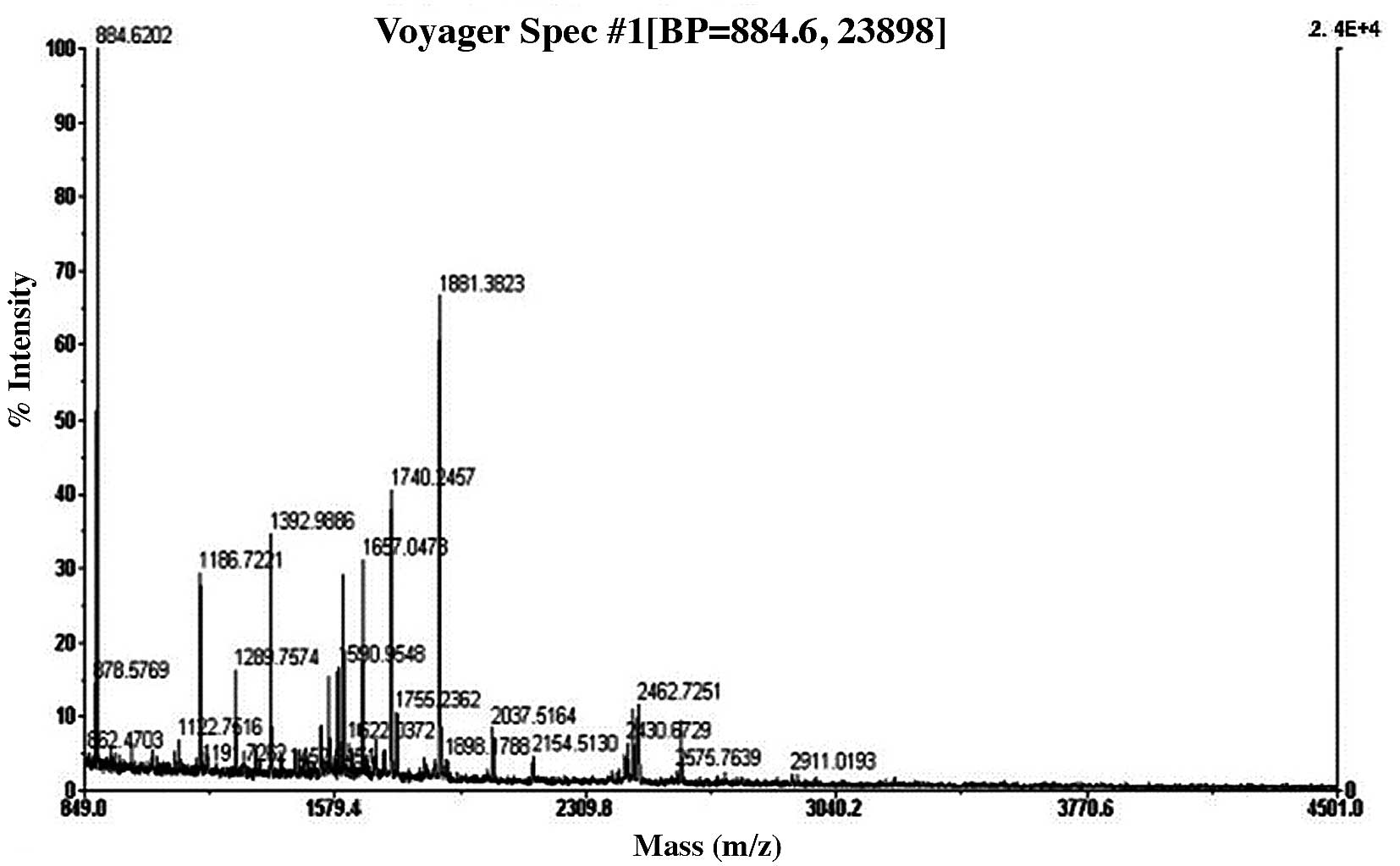|
1
|
Freund-Michel V and Frossard N: The nerve
growth factor and its receptors in airway inflammatory diseases.
Pharmacol Ther. 117:52–76. 2008. View Article : Google Scholar : PubMed/NCBI
|
|
2
|
Unsicker K, Huber K, Schütz G and Kalcheim
C: The chromaffin cell and its development. Neurochem Res.
30:921–925. 2005. View Article : Google Scholar : PubMed/NCBI
|
|
3
|
Barreto-Estrada JL, Medina-Ortiz WE and
Gareia-Arraras JE: The morphological and biochemical response of
avian embryonic sympathoadrenal cells to nerve growth factor is
developmentally regulated. Brain Res Dev Brain Res. 144:1–8. 2003.
View Article : Google Scholar
|
|
4
|
Forander P, Broberger C and Stromberg I:
Glial-cell-line-derived neurotrophic factor induces nerve fibre
formation in primaly cultures of adrenal chromaffin cells. Cell
Tissue Res. 305:43–51. 2001. View Article : Google Scholar : PubMed/NCBI
|
|
5
|
Wang J, Hu CP and Feng JT: Dysfunction of
releasing adrenaline in asthmatic adrenaline medullary chromaffin
cells due to functional redundancy primed by nerve growth factor.
Zhonghua Jie He He Hu Xi Za Zhi. 29:812–815. 2006.(In Chinese).
|
|
6
|
Li QG, Wu XR, Li XZ, Yu J, Xia Y, Wang AP
and Wang J: Neural-endocrine mechanisms of respiratory syncytial
virus-associated asthma in a rat model. Genet Mol Res.
11:2780–2789. 2012. View Article : Google Scholar : PubMed/NCBI
|
|
7
|
Lillien LE and Claude R: Nerve growth
factor is a mitogen for cultured chromaffin cells. Nature.
317:632–634. 1985. View
Article : Google Scholar : PubMed/NCBI
|
|
8
|
Unsicker K, Zwarg U and Habura-Flüh O:
Differentiation and transdifferentiation of adrenal chromaffin
cells of the guinea pig. III Transplants under the kidney capsule.
Cell Tissue Res. 229:299–308. 1983. View Article : Google Scholar : PubMed/NCBI
|
|
9
|
Livett BG: Adrenal medullary chromaffin
cells in vitro. Physiol Rev. 64:1103–1161. 1984.PubMed/NCBI
|
|
10
|
Unsicker K and Muller TH: Purification of
bovine adrenal chromaffin cells by differential plating. J Neurosci
Methods. 4:227–241. 1981. View Article : Google Scholar : PubMed/NCBI
|
|
11
|
Koike T: A possible involvement of
cytoplasmic Ca2+ in sodium dependency of neurite
outgrowth of rat pheochromocytoma PC12 cells. Biochim Biophys Acta.
763:258–264. 1983.PubMed/NCBI
|
|
12
|
Unsicker K, Krisch B, Otten U and Thoenen
H: Nerve growth factor-induced fiber outgrowth from isolated rat
adrenal chromaffin cells: impairment by glucocorticoids. Proc Natl
Acad Sci USA. 75:3498–3502. 1978. View Article : Google Scholar : PubMed/NCBI
|
|
13
|
Aletta JM, Shelanski ML and Greene LA:
Phosphorylation of the peripherin 58-kDa neuronal intermediate
filament protein. Regulation by nerve growth factor and other
agents. J Biol Chem. 264:4619–4627. 1989.PubMed/NCBI
|
|
14
|
Sterneck E, Kaplan DR and Johnson PF:
Interleukin-6 induces expression of peripherin and cooperates with
Trk receptor signaling to promote neuronal differentiation in PC12
cells. J Neuroehem. 67:1365–1374. 1996. View Article : Google Scholar : PubMed/NCBI
|
|
15
|
Leonard DG, Gorham JD, Cole P, et al: A
nerve growth factor-regulated messenger RNA encodes a new
intermediate filament protein. J Cell Biol. 106:181–193. 1988.
View Article : Google Scholar : PubMed/NCBI
|
|
16
|
Troy CM, Greene LA and Shelanski ML:
Neurite outgrowth in peripherin-depleted PC12 cells. J Cell Biol.
117:1085–1092. 1992. View Article : Google Scholar : PubMed/NCBI
|
|
17
|
Helfand BT, Mendez MG, Pugh J, et al: A
role for intermediate filaments in determining and maintaining the
shape of nerve cells. Mol Biol Cell. 14:5069–5081. 2003. View Article : Google Scholar : PubMed/NCBI
|
|
18
|
Sah VP, Seasholtz TM, Sagi SA and Brown
JH: The role of Rho in G protein-coupled receptor signal
transduction. Annu Rev Pharmacol Toxicol. 40:459–489. 2000.
View Article : Google Scholar : PubMed/NCBI
|
|
19
|
Meriane M, Mary S, Comunale F, et al:
Cdc42Hs and Rac1 GTPases induce the collapse of the vimentin
intermediate filament network. J Biol Chem. 275:33046–33052. 2000.
View Article : Google Scholar : PubMed/NCBI
|
|
20
|
Gibson RM, Gandhi PN, Tong X, et al: An
activating mutant of Cdc42 that fails to interact with Rho
GDP-dissociation inhibitor localizes to the plasma membrane and
mediates actin reorganization. Exp Cell Res. 301:211–222. 2004.
View Article : Google Scholar
|
|
21
|
Lin Q, Fuji RN, Yang W and Cerione RA:
RhoGDI is required for Cdc42-mediated cellular transformation. Curr
Biol. 13:1469–1479. 2003. View Article : Google Scholar : PubMed/NCBI
|
|
22
|
Michaelson D, Silletti J, Murphy G, et al:
Differential localization of Rho GTPases in live cells: regulation
by hypervariable regions and RhoGDI binding. J Cell Biol.
152:111–126. 2001. View Article : Google Scholar : PubMed/NCBI
|
|
23
|
LI Q, Ho CS, Marineseu V, et al:
Facilitation of Ca(2+)-dependent exocytosis by Rac1-GTPase in
bovine chromaffin cells. J Physiol. 550:431–445. 2003.
|
|
24
|
Qu MJ, Liu B, Qi YX and Jiang ZL: Role of
Rac and Rho-GDI alpha in the frequency-dependent expression of
h1-calponin in vascular smooth muscle cells under cyclic mechanical
strain. Ann Biomed Eng. 36:1481–1488. 2008. View Article : Google Scholar : PubMed/NCBI
|














